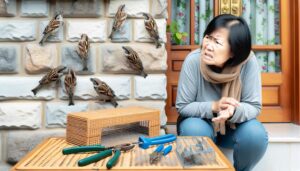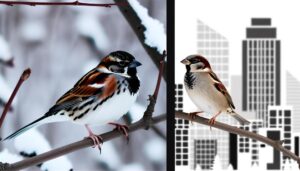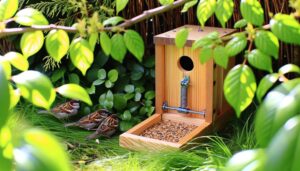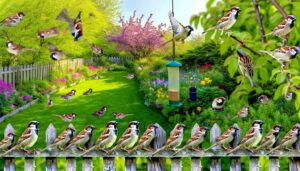How Do House Sparrows Mate for Life?
House sparrows (Passer domesticus) typically form socially monogamous pairs, often staying together for multiple breeding seasons. However, genetic studies reveal frequent extra-pair copulations, suggesting genetic diversity is maintained.
Courtship behaviors include wing flapping, tail spreading, and mutual preening, which strengthen pair bonds. Nesting is collaborative, utilizing diverse materials for insulation and structure.
Environmental factors such as resource availability and predation also influence their mating systems. Though pair bonds are generally robust and stable, dynamic environmental conditions can lead to mate switching.
Explore the intricate dynamics of their social and mating behaviors to understand more about these adaptable birds.

Key Takeaways
- House Sparrows typically form social monogamous bonds that can last multiple breeding seasons.
- Extra-pair copulations are common, meaning they may not be exclusively faithful.
- Pair bonds are strong and consistent but often short-term.
- Environmental factors like resource availability and predation pressure influence their monogamous behavior.
- While they may switch mates between seasons, they often remain with one partner during a breeding season.
House Sparrow Mating Overview
House sparrows (Passer domesticus) exhibit a complex mating system characterized by social monogamy, where pairs form long-term bonds but may engage in extra-pair copulations. This reproductive strategy involves both partners generally remaining together across multiple breeding seasons, thereby enhancing territorial defense and cooperative parental care.
However, genetic analyses reveal that offspring within a single brood may have different fathers, indicative of extra-pair matings. This behavior is hypothesized to increase genetic diversity and offspring viability.
Moreover, mate switching can occur, particularly if either partner perceives the potential for a higher-quality mate. Such dynamics underscore the balance between cooperation and competition, essential in understanding the evolutionary pressures shaping house sparrow mating systems.
Courtship Behaviors
Courtship behaviors in house sparrows involve a series of intricate displays and vocalizations designed to attract and secure a mate, reflecting the species' complex social dynamics. Males often perform energetic displays, including wing flapping and tail spreading, to showcase their physical fitness. Additionally, vocalizations play an important role, with males producing a variety of chirps and calls to signal their presence and readiness to mate. These behaviors are complemented by mutual preening, which strengthens pair bonds and facilitates mating success.
| Behavior | Description |
|---|---|
| Wing Flapping | Energetic movement to attract attention |
| Tail Spreading | Display of plumage to impress females |
| Vocalizations | Series of chirps and calls |
| Mutual Preening | Strengthens pair bonds |
| Physical Displays | Showcases physical fitness |
These activities are essential for mate selection and reproductive success in house sparrows.
Nesting Habits
House Sparrows exhibit specific nesting habits characterized by their choice of construction materials, which typically include grass, feathers, and twigs.
They preferentially build nests in sheltered locations such as eaves, cavities, and dense foliage.
The nesting season for House Sparrows generally spans from early spring to late summer, allowing multiple broods within a single season.
Nest Construction Materials
Sparrows exhibit a preference for a diverse array of materials in nest construction. They meticulously gather grasses, feathers, paper, twigs, and animal hair to create a secure and insulated environment for their offspring. These avian architects demonstrate remarkable adaptability in their choice of nesting materials, optimizing for both availability and functionality.
The construction process incorporates:
- Grasses: providing structural integrity and flexibility
- Feathers: offering insulation and cushioning
- Paper: utilized for its lightweight and easy-to-manipulate properties
- Twigs: contributing to the robustness of the nest framework
- Animal hair: enhancing thermal insulation
Preferred Nest Locations
In addition to their versatile nest construction materials, these resourceful birds show a keen preference for nesting locations that provide safety, accessibility, and proximity to food sources.
House Sparrows (Passer domesticus) often choose niches within human structures, such as under eaves, in crevices, or behind shutters, which offer protection from predators. They may also use dense vegetation, such as ivy-covered walls or thick hedges. The urban and suburban environments offer ample opportunities for these conditions, fostering their widespread presence.
Additionally, these locations often guarantee proximity to human-provided food sources, such as bird feeders and discarded food, enhancing their survival and reproductive success. This strategic selection of nesting sites contributes significantly to their adaptability and resilience.
Nesting Season Timeline
The nesting season for House Sparrows typically begins in early spring and can extend through late summer, characterized by multiple broods and a high degree of parental investment. During this period, House Sparrows exhibit distinct nesting habits and timelines:
- Initial Nest Building: Begins as early as March, with males constructing the foundation.
- Egg Laying: Females lay 3-7 eggs per clutch, usually in April.
- Incubation: Lasts 10-14 days, primarily conducted by the female.
- Fledging: Chicks leave the nest around 14-17 days post-hatching.
- Multiple Broods: Pairs can have up to four broods per season.
These behaviors underpin the reproductive success of House Sparrows, ensuring population sustainability through strategic nesting practices.
Pair Bond Formation
Pair bond formation in house sparrows encompasses several key behaviors, including initial attraction displays such as singing and feather fluffing.
Both males and females participate in nest building, which strengthens their bond through cooperative effort.
Seasonal variations influence the stability of these bonds, with many pairs reuniting annually to breed.
Initial Attraction Behaviors
Observing the initial attraction behaviors among house sparrows reveals a complex interplay of visual and auditory signals that facilitate pair bond formation. Males often initiate the process through a series of displays designed to attract females and establish dominance.
- Wing Fluttering: Males exhibit rapid wing movements to display vigor.
- Song: A repertoire of chirps and calls is used to communicate fitness and territorial claims.
- Feather Puffing: Males puff up their feathers to appear larger and more appealing.
- Food Offering: Presenting food to females signifies the male's ability to provide resources.
- Chasing: Males may chase females as a courtship behavior, demonstrating their agility.
These behaviors are important in the early stages of sparrow pair bonding, setting the foundation for subsequent reproductive activities.
Nest Building Roles
Following the intricate courtship displays, house sparrows engage in collaborative nest building, a critical stage in solidifying their pair bond and preparing for successful reproduction. Both the male and female sparrows participate actively, with the male often initiating the process by selecting a suitable site, typically in cavities or dense foliage.
He then presents materials such as grass, feathers, and twigs to the female, who inspects and contributes to the construction. This shared effort not only fortifies their bond but also secures a structurally sound nest, essential for the protection and nurturing of their future offspring.
The cooperative dynamics observed during this phase highlight the importance of mutual investment in reproductive success among house sparrows.
Seasonal Bond Strength
Throughout the year, the bond between house sparrow pairs exhibits varying degrees of strength, often intensifying during the breeding season when reproductive activities demand heightened cooperation. During this period, pairs engage in several behaviors that reinforce their partnership:
- Increased mutual preening: A behavior that strengthens social bonds and reduces parasites.
- Coordinated nest building: Both sexes participate in constructing and maintaining the nest.
- Joint territory defense: Pairs work together to fend off intruders and protect their nesting site.
- Synchronizing reproductive cycles: Ensuring that both partners are ready for mating simultaneously.
- Feeding young: Both parents share the responsibility of feeding and caring for the offspring.
These activities underscore the importance of a strong pair bond for successful reproduction and offspring survival.
Fidelity and Infidelity
House sparrows exhibit a complex mating system characterized by both monogamous bonds and instances of extra-pair copulations, which contribute to a dynamic interplay of fidelity and infidelity within their populations. Fidelity in house sparrows is often observed as pairs form and maintain bonds across multiple breeding seasons. However, genetic analyses have revealed that extra-pair copulations are not uncommon, indicating a level of infidelity. These behaviors enhance genetic diversity and can increase reproductive success. The table below provides a comparative overview of fidelity and infidelity in house sparrows:
| Aspect | Fidelity | Infidelity |
|---|---|---|
| Bond Duration | Multiple breeding seasons | Often short-term |
| Genetic Diversity | Limited | Enhanced |
| Reproductive Success | Stable but limited | Potentially increased |
| Pair Bond Strength | Strong, consistent | Variable, opportunistic |
This complex mating behavior underscores the adaptive strategies employed by house sparrows.
Factors Influencing Monogamy
Several ecological and biological factors influence the prevalence of monogamy in house sparrows, shaping their mating behaviors and reproductive strategies. These factors contribute to the complexity and variability observed in their social bonds.
Key elements include:
- Resource availability: Abundance of food can affect the stability of pair bonds.
- Predation pressure: Higher predation risks may promote tighter monogamous relationships.
- Parental investment: Both parents' involvement in offspring care can reinforce monogamy.
- Genetic compatibility: Genetic benefits can drive the selection of a single mate.
- Breeding density: High population density may lead to increased mate competition and infidelity.
Understanding these factors provides insight into the adaptive nature of monogamy in house sparrows and its role in their evolutionary success.
Impact of Environment
Environmental conditions play an important role in shaping the mating systems and social structures of house sparrows. Variability in food availability, nesting sites, and predation pressure can greatly influence their reproductive strategies.
In resource-rich environments, house sparrows are more likely to exhibit monogamous pairing due to stable conditions that favor long-term partnerships. Conversely, in habitats with fluctuating resources or high predation risk, sparrows may adopt more flexible mating systems, such as serial monogamy or polygyny, to maximize reproductive success.
Additionally, urban environments introduce unique challenges, such as pollution and competition for nesting sites, potentially altering traditional mating behaviors. Understanding these environmental impacts is vital for comprehending the adaptive strategies that house sparrows employ to thrive in diverse ecological settings.
Conservation Implications
Understanding the environmental factors that influence the mating behaviors of house sparrows is critical for informing effective conservation strategies aimed at preserving their populations.
Key conservation implications include:
- Habitat Preservation: Ensuring that sparrows have access to suitable nesting sites and food resources.
- Pollution Control: Reducing exposure to pollutants that may affect reproductive success.
- Climate Change Mitigation: Addressing climate shifts that could disrupt breeding patterns.
- Predator Management: Controlling invasive species that prey on sparrows or compete for resources.
- Human Interaction: Minimizing negative impacts from urban development and agricultural practices.
Conclusion
The mating behavior of house sparrows (Passer domesticus) reveals a complex interplay of monogamy and infidelity, influenced by environmental conditions and resource availability.
Although pair bonds are typically formed, instances of extra-pair copulations are not uncommon, suggesting that absolute lifelong monogamy is rare.
The fidelity of these birds is notably impacted by ecological pressures and habitat quality, necessitating further research to understand the adaptive significance of these behaviors for effective conservation strategies.






